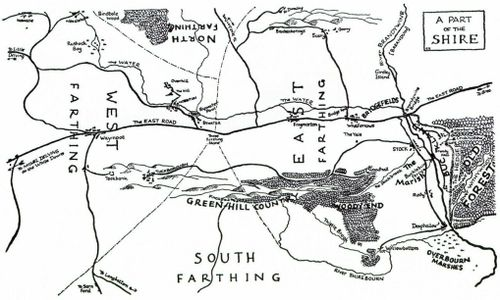Four Coins For The Shire
Let's talk about the Shire for a moment. Or, more specifically, the Farthings.
Tolkien, in the Appendix on Languages, went strongly with the conceit that he was really translating an ancient document, often using equivalent words in English. "Farthing" is, of course, a unit of British currency; in The Peoples of Middle Earth, he makes it explicit in that the designation was based on a coin called the castar, which was one fourth of the Gondorian (and presumably Arnorian) silver coin called the tharni.
The division seems a little unusual for the mostly anarchic hobbits; rather than the "folklands" associated with specific families, it appears to be an administrative division. The only government services, we are told, are the Messenger Service and the Watch. The Watch, in turn, is specifically said to consist in part of 12 Shirriffs, 3 for each Farthing.
The hobbits appear to have had little use for a centralized authority amongst themselves; they acknowledged the leadership of Arthedain, and honored their agreements with the nation. It was only with the dissolution of the realm that they finally chose a leader of their own. It was 4 years after the Battle of Fornost, that the hobbits elected democratically a Thain, a placeholder for royal authority, to command the Shire. Bucca of the Marish was notably not associated with a clan (although founding the Oldbuck family) when elected. Likely, considering the martial role of the position, he was a former soldier, probably an archer, in the Arthedain military. As such, he would want to work on making the Shire as defensible as possible.
Because of its size, it is likely that he was the one to create the idea of the Farthings, with a centralized location in each for the regional gathering of the Shire-muster. To facilitate communication, a Messenger Service would be established to keep the various parts of the Shire abreast of developments. At the same time, the hobbits did not wish do be perpetually be under emergency rule, so they would develop a civilian government - an elected Mayor for each of the main settlements of the Farthings that would run the Messenger Service during peaceful times; moreover, in place of a standing army, each Farthing would have a number of Shirriffs to 'keep the peace' (with the ability to deputize hobbits if necessary).
With time, the Oldbuck family decided to create the new Eastmarch across the Brandywine; while the post appears to have been made hereditary, that they were no longer within the bounds of the original Shire meant that they were giving up the role of Thain. Another election was held (odd that the Shire is the only participatory democracy in Middle-Earth!) and it was little surprise that the Took family took over the stewardship. We have during their tenure the Battle of Greenfields, the Days of Dearth / Long Winter, and then finally the Fell Winter before War of the Ring itself, indicating the long periods between when the Thains were actively leading the Shire.
Over time, the Shire's Messenger Service appears to have evolved from military/news communications to something resembling the modern-day Postal Service. The Shirriffs became less necessary (although the Bounders, those watching the edges of the Shire, probably ebbed and flowed over the years). As Michel Delving became the largest settlement in the Shire, its Mayor probably became more important than the others and became the effective peacetime leader of the Shire.
A bit further speculation, on the four 'capitals': each likely were the only ones to have a "Mayor":
Michael Delving is almost certainly the original capital of the West Farthing.
Whitfurrows, being the first village on the Great Road beyond the Brandywine Bridge (the only crossing over the river for a significant distance in both directions) and at a crossroads, is likely the capital of the East Farthing.
Longbottom, one of the few actual settlements of the South Farthing, was centrally located to watch any movement from Sarn Ford
Similarly, Oatbarton is one of the few known settlements of the North Farthing, and again seems to be centrally located.


Comments
Post a Comment